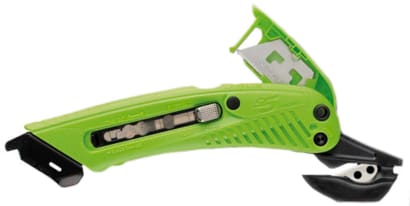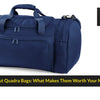Safety Cutter Best Practices: How to Avoid Common Cutting Mistakes
- by Mike Johnson

In busy work environments like warehouses, workshops, or construction sites, cutting tools are essential for everyday tasks. However, using cutting tools incorrectly can lead to accidents, material damage, and lost time. That's where the safety cutter comes into play. Designed specifically to reduce risks and improve efficiency, safety cutters provide features like automatic blade retraction, ergonomic handles, and secure blade storage.
At Active Workwear, we know that having the right tool can make all the difference. That's why we offer a variety of safety cutters designed to ensure both safety and performance. In this post, we'll dive into common cutting mistakes and highlight best practices to help you avoid them, ensuring you get the most out of your safety cutter while staying safe.
Common Cutting Mistakes
Using the Wrong Tool for the Job
It's easy to grab the nearest knife or cutter for a task, but using the wrong tool can lead to problems. For instance, using a basic knife instead of a safety cutter increases the risk of injury and can damage the material you're working on.
A tool like the Pacific Handy 3 In 1 Right Hand Safety Cutter is specifically designed to handle tasks like box cutting, film cutting, and tape splitting, all with built-in safety features. It prevents puncture wounds with a blunt safety tip, and its ergonomic design ensures that it fits comfortably in the hand, reducing the chance of slips or strain during use.
Without the right tool, not only are you putting yourself at risk, but you're also risking damage to the product. For example, using a knife without a proper blade guard can slice through merchandise, causing unnecessary loss. Ensuring you have the correct tool for the job from the start saves time, reduces waste, and keeps safety in check.
Neglecting Blade Sharpness
Blunt blades are a major cause of accidents. When the blade isn't sharp enough, you have to exert more force to make a cut, which can lead to slips and accidents. A dull blade doesn't just slow you down; it also increases the likelihood of injuries, as you're less in control when applying excessive force.
One solution is to use a tool with an automatic blade replacement feature, like the Pacific Handy Auto Loading Utility Warehouse Knife. This tool allows for seamless automatic blade replacement, ensuring you always have a sharp blade on hand without needing to stop work to manually change the blade. A sharp blade not only ensures cleaner cuts but also reduces the effort required, making the cutting process smoother and safer.
Checking your blade sharpness regularly is a key habit to develop. If you notice the blade is struggling to cut through materials, it's time to replace it. Keeping your blades sharp will not only protect you but also improve the efficiency of your work, cutting down on time spent dealing with mishaps.
Cutting at the Wrong Angle
The angle at which you cut can significantly impact the results. Cutting at a poor angle can lead to jagged cuts, damaged materials, or even injury if the blade slips. It's important to hold the safety cutter at the correct angle for the material you're cutting.
For instance, when cutting through corrugated cardboard, positioning the blade at a shallow angle can help you glide through the layers more efficiently, while a more direct angle can result in resistance or tearing. The Pro Safety Cutter helps with this, as its automatic blade retraction system ensures that the blade retracts quickly after each cut, allowing for better control and safety.
Cutting with precision not only ensures clean results but also protects the user. It's a good practice to assess the material you're cutting and adjust your technique accordingly. Proper technique, combined with the right tool, minimises the risk of accidents and enhances productivity.
Best Practices for Safe Cutting
Choose the Right Safety Cutter for the Job
Every task is different, and choosing the right safety cutter for your specific job is crucial. For tasks that involve multiple types of cuts, such as box cutting, film cutting, and tape splitting, using a cutter with built-in safety features can significantly reduce the risk of accidents. Safety mechanisms like blade exposure control are key to preventing injuries and ensuring efficiency.
For heavier tasks where you may need to change blades often, consider a tool that offers quick and seamless blade replacement. This keeps the work flowing without unnecessary interruptions, ensuring you always have a sharp blade ready when needed.
Always assess your cutting needs before selecting a tool. A more complex job might require a multi-function safety cutter, while simpler tasks could be handled with a basic utility knife. The right tool ensures both speed and safety, while reducing the risks associated with improper cutting techniques.
Keep Blades Sharp and Ready to Use
Sharp blades are essential for safe and efficient work. A dull blade forces you to apply more pressure, which leads to fatigue, inaccuracy, and increased risk of injury. Regularly inspect your safety cutter and replace the blade as soon as it begins to dull.
Using a cutter that allows for quick and easy blade replacement is especially important in fast-paced environments, where every second counts. This ensures that you can maintain productivity without compromising safety.
Always keep a supply of replacement blades nearby to avoid delays. Don't wait until the blade is completely worn down before changing it. The moment you feel resistance or notice uneven cuts, swap out the blade for a fresh one to ensure continued efficiency and safety.
Use Proper Technique and Control
Cutting safely isn't just about having the right tool - it's about using the correct technique. Always ensure your hand is steady, and apply consistent pressure throughout the cut. Avoid rushing, as this can lead to accidents.
When using a safety cutter like the Pro Safety Cutter, the automatic blade retraction system is there to protect you, but you still need to maintain control throughout the cut. Make sure your fingers are out of the blade's path and that the material is properly secured before cutting.
Proper technique also means paying attention to your cutting angle, as mentioned earlier. Ensuring the blade enters the material at the right angle will give you smoother cuts, reduce strain, and minimise the risk of errors or injury.
Store Safety Cutters Safely
When not in use, store your safety cutters securely to avoid accidental injuries. Keeping them in a designated toolbox or holster ensures that the blades remain out of harm's way when not in use. Proper storage also prevents damage to the tool itself, prolonging its lifespan.
Using a holster, like the UKH-326 Leather Holster paired with the Pacific Handy Auto Loading Utility Knife, allows for easy access to your tool while keeping it safe and secure when not needed. Safe storage is an essential part of maintaining a safe workplace.
Maintaining Safety in the Workplace
Regular Safety Training
Even the best tools are only as safe as the people using them. Providing regular training on proper safety cutter techniques and maintenance can significantly reduce workplace accidents. Make sure that all employees know how to handle safety cutters, when to replace blades, and how to store them properly.
At Active Workwear, we encourage businesses to integrate tool safety training into their regular routine. The more familiar employees are with best practices, the safer and more productive the workplace will be.
Keep Spare Blades Handy
Having spare blades readily available ensures you can maintain productivity without sacrificing safety. A dull blade should never be used simply because a replacement isn't at hand. Keeping spare blades within reach helps reduce downtime and keeps your cutting operations efficient.
By keeping replacement blades easily accessible, you minimise delays and ensure smooth workflow. It's always better to be prepared, so make sure you have the necessary supplies before starting any task.
Conclusion
By following these best practices, you can avoid common cutting mistakes and ensure a safer, more efficient workplace. Having the right tool and using it correctly is essential to maintaining both safety and productivity.
At Active Workwear, we're committed to providing high-quality tools that help you work safely and efficiently. Explore our range of safety cutters today and keep your workplace injury-free.
FAQs on Safety Cutters and Best Practices for Cutting Safely
1. What is a safety cutter, and how does it differ from a regular cutter?
A safety cutter is designed with special features, such as automatic blade retraction and ergonomic handles, to reduce the risk of accidents and injuries. Unlike regular cutters, which often expose more blades than necessary, safety cutters minimise blade exposure to protect the user and the materials being cut.
2. Why is it important to keep blades sharp in a safety cutter?
Sharp blades are essential for ensuring smooth, precise cuts and reducing the need for excessive pressure, which can lead to accidents. Using a dull blade increases the risk of slips, inaccuracies, and injuries. Regularly replacing or sharpening your blade keeps cutting tasks safe and efficient.
3. How can I avoid common cutting mistakes in the workplace?
To avoid common cutting mistakes, always use the right safety cutter for the task, maintain sharp blades, and apply proper cutting techniques. Using the right angle, steady pressure, and securing the material before cutting are all key to preventing accidents and ensuring clean, precise cuts.
4. What are the benefits of using safety cutters over traditional knives?
Safety cutters offer numerous benefits over traditional knives, including built-in safety features like automatic blade retraction and ergonomic designs. These features reduce the risk of accidents, prevent material damage, and provide greater control during cutting tasks, making them ideal for workplace use.
5. How often should I replace the blade in my safety cutter?
You should replace the blade in your safety cutter as soon as you notice it becoming dull, which could result in uneven cuts or require more force. Keeping spare blades on hand ensures that you can switch them out quickly and continue working efficiently without compromising safety.
6. What is the best way to store safety cutters when not in use?
Safety cutters should be stored in a designated area or tool holster when not in use. This prevents accidental injuries and ensures the blade is secure. Proper storage also extends the lifespan of the tool and keeps your workspace organised.








